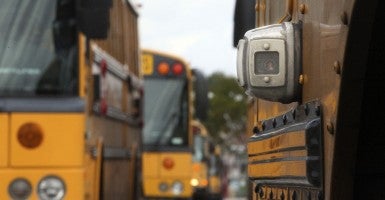Better be extra cautious when passing a school bus.
Redflex Traffic Systems is partnering with 19 Virginia school districts to install cameras on buses to catch drivers who ignore their stop signs.
The cameras would be installed about six feet behind the bus’ stop-arm to monitor traffic in both directions. The system activates when the stop arm and red lights are displayed and children are entering or exiting the bus.
Evidence of violations gathered by Redflex, including video and high-resolution images, is sent to local law enforcement to review and determine whether a violation occurred and whether a driver should be cited. Redflex prints the citation and mails it to the car’s registered owner.
But is it Redflex’s job to issue such a citation?
John Whitehead, president of The Rutherford Institute, a nonprofit civil liberties organization, doesn’t think so.
“[It’s] not a state organization, not the police,” Whitehead said. “What you’re dealing with … it’s a huge money-making scam. It’s trying to find ways to make monies off of the average citizen who makes mistakes. I’ve driven by buses all my life. I’ve never seen anybody ignore a stop sign.
“It’s the corporate police state. [If] they’re going to do that, which I oppose by the way, there has to be some kind of screening device. If a bus drives through a neighborhood, it can pick up all kinds of information. They’ll be watching everyone.”
The method used is fairly standard throughout the ticket-camera industry, according to John Bowman, spokesman for the National Motorists Association.
They’ll tell you, sure, we send all of the tickets to the police officer for review. I’m not exactly sure how diligent that project actually is. I can certainly understand why motorists would think that any kind of traffic enforcement camera (either on a bus or a red-light camera or speed camera) is an invasion of privacy. I would feel the same way. From a legal standpoint, however, the courts have ruled that motorists out on a public road don’t have an expectation of privacy. So, it becomes difficult to challenge the cameras on that basis.
According to a 2013 study of 29 states by the National Association of State Directors of Pupil Transportation Services, more than 85,000 vehicles illegally passed 108,000 school buses per day, according to Redflex’s spokeswoman Jody Ryan. Redflex is a member of the NASDPTA’s supplier council.
Bowman said if this truly was about safety, resources should go instead to proper training for school bus drivers as opposed to ticket-writing cameras. He pointed to a National Highway Traffic Safety Administration report that found children are eight times safer riding a school bus to school than going in passenger vehicles.
Another NHTSA report said that of the 1,351 people who died in school-bus-related accidents between 2002 and 2011, only 123 were school-age pedestrians. But most school children killed in school-bus related accidents during the past 10 years were killed by the bus, not by a passing motorist.
“The risk of a school child getting hit by a passing car is miniscule,” he said. “Overall, it’s one more revenue scheme on the part of the cameras they play on the emotions of parents, teachers and people within the school district.”
Redflex says 70 school districts in 10 states use Redflex Guardian, including one district in Georgia that recently selected it to install cameras on 300 buses.
Chesterfield County Public Schools is the latest Virginia school district to test drive the stop-arm enforcement product. In its pilot study, Reflex cameras mounted on school buses caught 216 violations in a 32-day period. If Chesterfield County were to implement the cameras, the school division would receive only $85 of the $250 citation. Redflex would get the remaining $165.
Former Gov. Robert McDonnell, a Republican, approved an amendment to state code in 2011 that authorized municipalities to adopt ordinances that would allow school districts to operate video-monitoring systems in or on school buses to catch drivers in the act of passing stopped buses.
The legislation got 96 votes in the 100-member House of Delegates and all 40 votes in the State Senate.
The year the measure passed, Hunton and Williams, a law firm that represents the company, donated $48,175 to McDonnell’s campaign and inauguration. The firm also contributed to current Gov. Terry McAuliffe, a Democrat, to the tune of $25,000 for his inauguration, $10,599 for his gubernatorial campaign and $10,000 to the state Democratic Party. McAuliffe rewarded the contributors with a veto earlier this year on legislation that would have given camera-ticketed motorists a second appeal.
Chesterfield County Public Schools do not seem concerned. Tim Bullis, the community relations director, told the Chesterfield Observer that school officials are looking forward to working with the company.
“We are confident that the company had addressed [its] past issues,” Bullis said.
Prince George County already installed the cameras on six buses. In its contract with Prince George County, Redflex said there will be no up-front cost to the county.
“Now we’re in the penalty stage and issuing citations,” said Ronald Rhodes, the director of transportation for Prince George County.
Reactions to the school bus cameras is mixed, according to Dana Schrad, executive director of the Virginia Association of Chiefs of Police.
“It’s still a new program,” Schrad said. “(Law enforcement) are very cautious about adopting a new program. They want to make sure they are following the letter of the law. That’s one of the reasons I told Redflex to talk to the law enforcement agency first, and (they) can tell you whether they feel like they would work out well.”






























